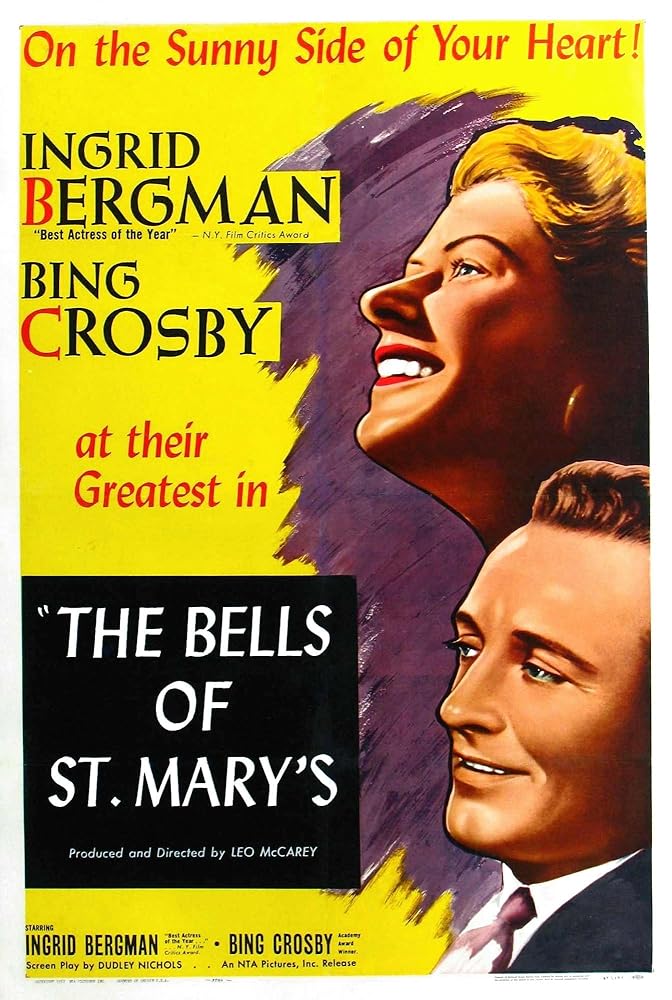
BELLS OF ST. MARY’S, THE
(director: Leo McCarey; screenwriter: from a story by Leo McCarey/Dudley Nichols; cinematographer: George Barnes; editor: Harry Marker; music: Johnny Burke/Jimmy Van Heusen/Robert Emmett Dolan; cast: Bing Crosby (Father Chuck O’Malley), Ingrid Bergman (Sister Mary Benedict), Henry Travers (Horace P. Bogardus), William Gargan (Patsy’s father), Ruth Donnelly (Sister Michael), Una O’Connor (Mrs. Breen), Rhys Williams (Dr. McKay), Joan Carroll (Patsy Gallagher), Martha Sleeper (Mrs. Gallagher), Bobby Frasco (Tommy), Dickie Tyler (Eddie); Runtime: 127; MPAA Rating: NR; producer: Leo McCarey; RKO; 1945)
“Winsome and highly commercial sequel to Going My Way.”
Reviewed by Dennis Schwartz
Winsome and highly commercial sequel to Going My Way, with Bing Crosby reprising his role as the pipe-smoking trouble-shooting crooning priest transferred to another rundown parish where Barry Fitzgerald’s mischievous twinkle is replaced by Ingrid Bergman’s womanly nun. Academy Award winning director Leo McCarey (“Going My Way”/”Let’s Go Native”/”The Awful Truth”) directs this one with the same sentimentality and embarrassing coyness. The film was a big hit at the box office.
Father O’Malley (Bing Crosby) is assigned as the new pastor of NYC’s financially-strapped St. Mary’s church and its parochial elementary school. The housekeeper Mrs. Breen (Una O’Connor) cautions him that the rebellious nuns drove the previous priest into a wheel-chair and a rest home. The school’s principal is Sister Mary Benedict (Ingrid Bergman), the Mother Superior, who is disappointed that the school building is falling apart and prays that the wealthy owner of the new office building being built next to theirs, Horace P. Bogardus (Henry Travers), will find it in his heart to donate his building to the church. When Father O’Malley chats with Bogardus, he learns that unless the church agrees to sell him the school to use as a parking lot he will encourage, as a board member, that the city council condemn it.
Using a number of episodes, the film’s narrative unfolds: O’Malley and Benedict differ over teaching methods; they help bring together a broken marriage, where one of their pupil’s musician father who split when she was born now gets back together with the girl’s mom; Sister Benedict teaches a student how to box so he won’t be picked on by a bully; Father O’Malley softens the heart of the old codger Bogardus to donate the building to St. Mary’s by convincing him that he’s only got a few months to live and would really be remembered for this good deed; the kids of St. Mary’s put on a revised modern stage version of the Nativity, adding a chorus of “Happy Birthday” to Jesus’s birth; and finally Father O’Malley has to deal judiciously with Sister Benedict being transferred to a lighter church duty in a place with a better climate because of her tuberculosis.
It’s sentimental hokum shrewdly put together where songs are sung, heartstrings are tugged and everyone walks away feeling good about these caring church people. Crosby croons “Adeste Fidelis,” “In the Land of Beginning Again,” and the uplifting “Aren’t You Glad You’re You.” The performances by the two stars are seamless.
Leo McCarey’s aunt was the nun who was the inspiration for Sister Benedict, and the one that inspired Bergman when she met with her to research her role.
REVIEWED ON 3/14/2007 GRADE: B-